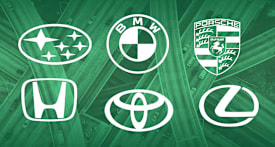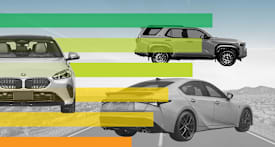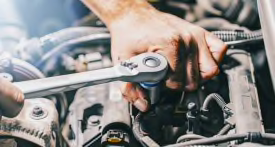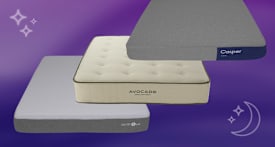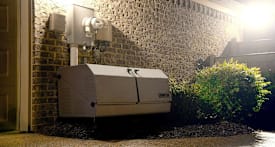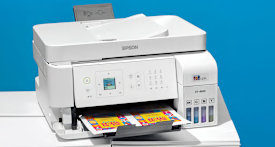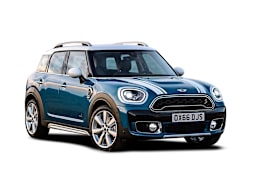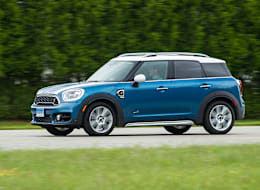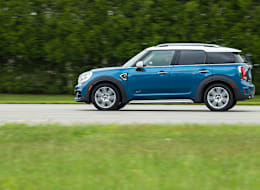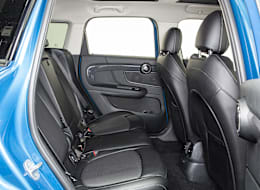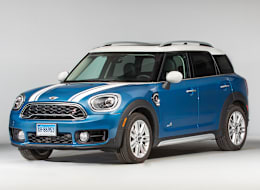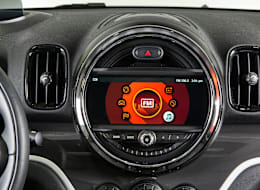Although the new Countryman -- the biggest Mini yet -- is designed to compete with compact premium SUVs, it still embodies Mini's trademark character. That uniqueness extends beyond the car's physical shape to the brand's cheerful, irreverent demeanor as well as the fun-to-drive nature of the car.
The main engine offerings for the Countryman are a 134-hp, 1.5-liter turbocharged three-cylinder in the base Cooper or, in the Cooper S, a 189-hp, 2.0-liter turbocharged four-cylinder. We opted for the latter in our Cooper S Countryman All4, which is Mini-speak for its all-wheel-drive version. This makes it comparable with models such as the Audi Q3, Mercedes-Benz GLA, and BMW X1 -- which shares a platform with the Countryman (Mini is owned by BMW).
On the road, the Countryman proves agile thanks to its quick steering and distinct exhaust sound, which combine to make the Mini fun to drive. At 3,600 pounds the Countryman may not be the go-kart its pint-sized hatchback brethren are, but it still corners with remarkable enthusiasm.
With the larger 2.0-liter turbo and eight-speed automatic, the Countryman feels zippy and responsive. The transmission plays harmoniously with the turbo's rich power. We believe that when paired with the less-powerful, three-cylinder engine (which we tested in our 500-pound-lighter Cooper Clubman), the Countryman would struggle to move with authority. Fuel economy for our AWD Countryman is 25 mpg overall, which is par for the course.
The Countryman may very well be the most comfortable Mini, but the ride is still firm and for some, may seem dissonant with the car's premium price. The suspension has a layer of absorbency, and the body remains tightly controlled and tied down, thankfully free of the choppiness that characterized earlier Minis. In addition, while the Countryman isn't quiet, noise levels aren't objectionable. Road noise is fairly well suppressed, although at highway speeds wind noise is pronounced.
Inside is the usual-for-Mini celebration of style and character, including chrome-tipped toggle switches mounted both low on the dash and up on the ceiling, along with other funky details. However, we welcome that controls such as those for windows, locks, and mirrors adjustment are placed in traditional spots. This includes the speedometer, which now sits right in front of the driver. This conventional positioning frees up the large round center gauge pod for the infotainment screen.
That infotainment system is handled via a touch screen or center control knob that interacts with the screen, much like the iDrive in BMW models. It certainly requires a learning curve, but once mastered, it's logical to use. Conveniently, changing radio stations and initiating or receiving phone calls can be done with steering-wheel controls while viewing the action in the optional head-up display.
The optional power driver seat adds a measure of luxury and the seat itself is very supportive, even for the long haul. The supportive rear seat has ample space and encourages good posture, and can accommodate three adults, although not comfortably.
While the cargo space is modest, the rear seats can slide forward and back enabling a bit more space for passengers, cargo, or both.
It's rather astonishing that at this price our Mini lacks advanced safety features, and that a blind-spot monitoring system isn't even available. You can get automatic emergency braking and lane-departure warning as part of the Active Driver Assistant option, but it requires an additional package called Fully Loaded.
Be mindful as you're equipping your Mini, since just a few desirable option packages can bring the price of a Cooper S All4 to $40,000. That may sound steep, but Mini has never been a budget brand.
Sure, we love driving this maxi-Mini because it is super fun to drive with a credible practical side. It just may not be everyone's cup of tea.
